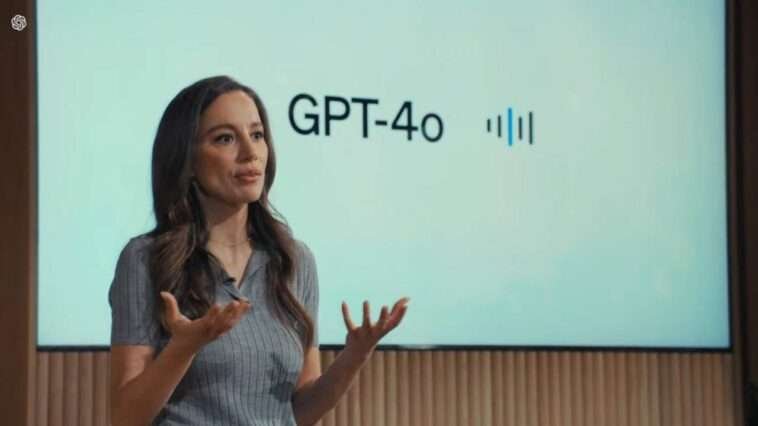In the rapidly evolving landscape of artificial intelligence, OpenAI continues to lead the way with groundbreaking advancements. Recently, OpenAI unveiled its latest large language model, GPT-4o, an update from the previous GPT-4 model. This article delves into the key differences between GPT-4 and GPT-4o, how to access GPT-4o, and the potential implications of this new release.
Key Differences: GPT-4 vs. GPT-4o
1. Enhanced Conversational Abilities
GPT-4: GPT-4, introduced over a year ago, significantly improved the capabilities of AI-driven conversations, offering more coherent and contextually relevant responses than its predecessors. It has been widely used across various applications, from chatbots to content creation tools.
GPT-4o: GPT-4o takes conversational abilities to a new level by enabling real-time spoken conversations. During OpenAI’s recent demonstration, GPT-4o effectively turned ChatGPT into a digital personal assistant. It can engage in natural, human-sounding dialogues and even respond in a robot voice or sing, making interactions more dynamic and lifelike.
2. Multimodal Interactions
GPT-4: While GPT-4 was a powerful text-based model, its interaction capabilities were limited to textual input and output.
GPT-4o: GPT-4o introduces multimodal interactions, allowing users to upload and discuss screenshots, photos, documents, or charts. This feature significantly expands the utility of ChatGPT, making it more versatile in handling various forms of information beyond text.
3. Memory Capabilities
GPT-4: GPT-4 could retain context within a single conversation but lacked long-term memory capabilities.
GPT-4o: With GPT-4o, OpenAI has introduced memory capabilities that enable the model to learn from previous conversations with users. This allows for more personalized and contextually aware interactions, enhancing user experience by remembering preferences and past interactions.
4. Real-Time Translation
GPT-4: While GPT-4 was proficient in understanding and generating text in multiple languages, it did not support real-time translation.
GPT-4o: GPT-4o can now handle real-time translation, automatically translating and responding in multiple languages. This feature supports over 50 languages, making GPT-4o a powerful tool for global communication.
5. Emotional Detection
GPT-4: GPT-4 did not have the capability to detect and respond to users’ emotions.
GPT-4o: GPT-4o can detect users’ emotions through cues such as breathing patterns and respond accordingly. This emotional intelligence can provide a more empathetic and supportive user experience.
How to Access GPT-4o
OpenAI has made accessing GPT-4o straightforward and inclusive. Here are the steps to access this advanced AI model:
- ChatGPT Platform:
- GPT-4o will be available on the ChatGPT platform, accessible to both unpaid and paid users. Free users will have a limited number of interactions with GPT-4o before reverting to GPT-3.5.
- ChatGPT Desktop App:
- OpenAI is launching a ChatGPT desktop app featuring GPT-4o capabilities. This provides another platform for users to interact with the latest technology.
- Developer Access:
- Developers can utilize GPT-4o through OpenAI’s GPT store, enabling them to build custom chatbots and applications. This feature will also be available to non-paying users, democratizing access to advanced AI tools.
- Multilingual Support:
- The real-time translation feature and support for over 50 languages will be accessible to all users, enhancing the global reach of GPT-4o.
Implications of GPT-4o
The introduction of GPT-4o marks a significant step forward in AI technology. Its enhanced conversational abilities, multimodal interactions, memory capabilities, real-time translation, and emotional detection position it as a leading tool in the AI arms race. OpenAI’s focus on improving ease of use and accessibility ensures that more people can benefit from these advancements.
Competitive Edge
OpenAI’s release of GPT-4o comes at a critical time, with competitors like Google and Meta also advancing their AI technologies. Google’s Gemini AI model and anticipated AI integrations from Apple highlight the intense competition in the AI space. By launching GPT-4o ahead of these announcements, OpenAI aims to maintain its leadership position.
Broader Integration
The updated technology will likely benefit Microsoft’s integration of AI into its products, given their substantial investment in OpenAI. This broader integration could drive further adoption of AI across various consumer and enterprise applications.
GPT-4o represents a significant evolution in OpenAI’s AI technology, offering unprecedented capabilities and accessibility. Whether you’re a developer, business owner, or everyday user, GPT-4o promises to enhance interactions and productivity through its advanced features. As AI continues to evolve, GPT-4o sets a new standard for what is possible in digital personal assistants and conversational AI.
In the ongoing comparison of GPT-4 vs. GPT-4o, it is clear that GPT-4o’s advancements make it a game-changer in the realm of artificial intelligence.





